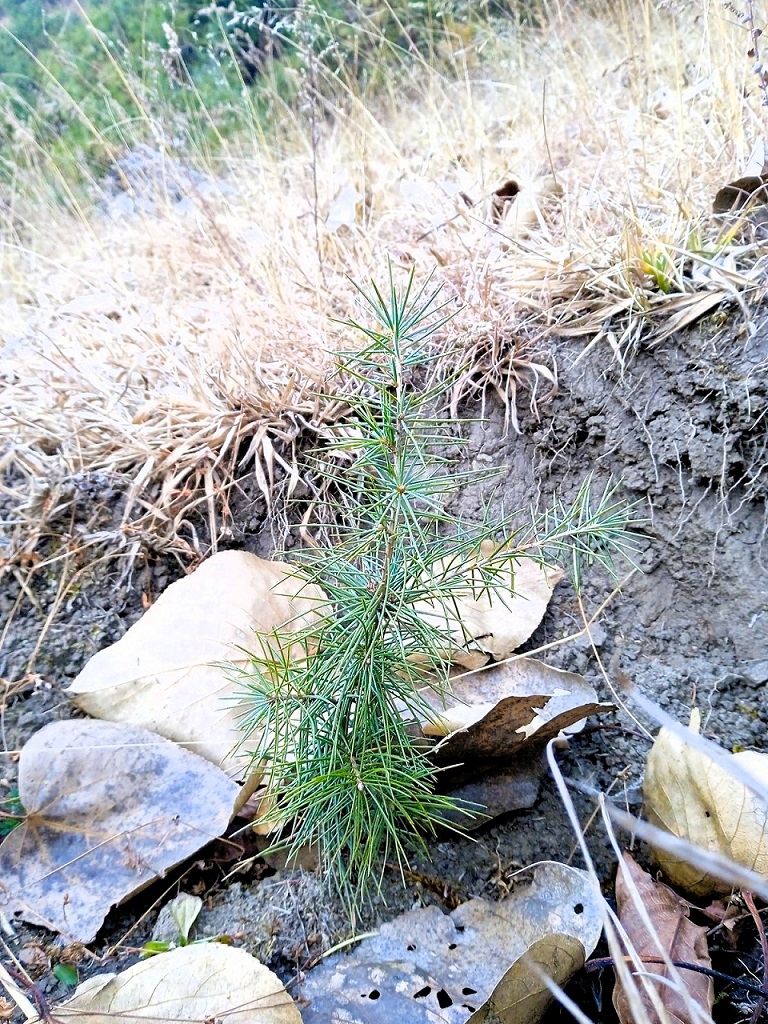Extract from the report on the Nepal 2022 mission.
From the Tatopani district, we set off again for Jumla. We have to drive without taking too many breaks, as the journey will be long, and we need to reach the reforestation site before nightfall.
After another hectic road trip, we reach Siddibhinayak, from where it's over an hour's walk to the plantation site.
We're pressing on, despite the difference in altitude, which we're feeling very tired of. These are the last major pedestrian efforts of our mission. Several dozen metres from the first replanted trees, we spot what we identify as Himalayan magpies. There were at least 4 of them, and they seemed to be playing between a stump on the ground and a nearby tree. We took the time to observe these beautiful birds, and to photograph them.
We then make our way to the plot:
Here, no fewer than 3,000 trees have been replanted over 2.3 hectares.. After a few years, this plot of land will form part of a forest corridor linking the Red Panda's current natural habitat (around 23 ha) to areas that are currently more deforested.

The plants grew in a nursery in Sinja, in the same district, funded by the Red Panda Network (RPN). They took 1 to 5 years to grow, depending on the species, and 3 hours by lorry on the same arduous journey, before finally being replanted here on 26 July.
In total, 106 people from the community were hired for this work, which was a real challenge: the height difference on the plot is impressive. They received a salary of 2,000 Nepalese rupees each, and are proud to be part of this new conservation effort.
To optimise habitat restoration, 5 species that are indigenous and important to the area have been selected: Himalayan cedar (Cedrus deoara), Himalayan pine (Pinus wallichena), common walnut (jungal regia), Himalayan white oak (Quercus leucotrichophoa) and Himalayan birch (Betula utilis)
Bamboo is deliberately not included among the plants. The species is found higher up, and when biotope conditions allow, it will grow naturally in the right places.
To ensure the long-term survival of the plants, a member of the community monitors the site daily, paid 5,000 rupees a year by the RPN. He makes sure that local people and livestock do not enter the area.
The RPN also employs 2 forest rangers who patrol the area periodically, as well as neighbouring territories. They are paid 10,500 rupees a year.
Daylight is fading fast. After gathering information, we took stock of the situation and took some pictures. We deplore the large amount of plastic waste present. While the fences are effective against intruders, they don't stop the various forms of pollution. We discussed the problem, which is omnipresent throughout Nepal.
Here, a periodic collection is carried out by the three guards, who are often assisted by other members of the community.
We can see that the trees replanted here 4 months ago are in good health. They are still very young and fragile. Each plant is easy to spot, as they are spaced out in small "craters". This allows good irrigation of the roots, and the plants that are visible in this way are also better monitored during their growth.

The entire plot is bordered by a small forest, sparse in places, which will also benefit from the proximity of this brand new plant corridor. This is just the beginning of a reforestation project that will last several years, but whose ecosystem will soon be back in action, with the return of the small flora and fauna that benefit from a protected area.
On our return walk, we passed many local people, many of whom stopped to say hello to the Nepalese members of our team, as they all knew each other well. The actions set up here by the members of the Red Panda Network in conjunction with members of the district social action team, represented by Tek Rawat, who is also accompanying us, are a real benefit to the local population. Here again, they are happy with the actions put in place to transform the difficulties of the past into environmental potential that will enable not only eco-tourism, but also sustainable natural and economic resources.
We crossed a suspension bridge and continued on our way... then we were surprised to be introduced to the Minister of the Armed Forces who was also passing by, with members of the community, in all simplicity. Our team explained the reasons for our visit, and we were warmly thanked by the Minister for our actions in France. We are touched by the gratitude shown to us, and are passing on these words to all our partners and supporters!
We then set off again for Jumla, where we were delighted to return to the hotel where we stayed in 2018, and to see the family who welcomed us there. These people are passionate about protecting the mountains that surround them and the animals that live there. Our old logo is still on the front door! We thank them for their local support, and offer them the new logo. The youngest boy hastens to replace the old sticker, and the reunion is always a moment of mutual goodwill!
